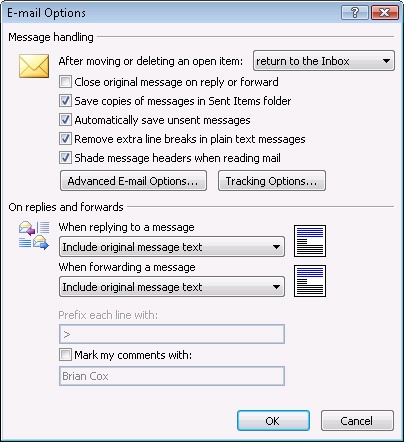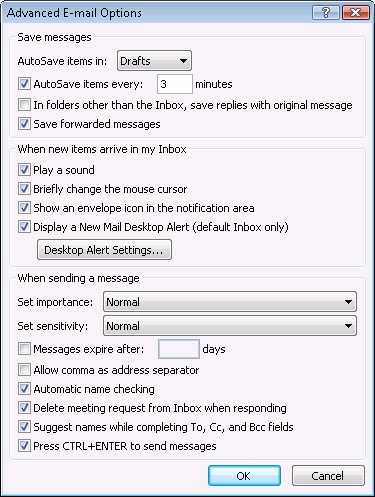Using the Outlook 2007 e-mail features effectively requires more than understanding how to send and receive messages. This section of the chapter helps you get your messages and attachments under control.
You can configure Outlook 2007 to save messages automatically in several ways—for example, saving the current message periodically or saving a copy of forwarded messages. You’ll find most of the following options in the E-Mail Options dialog box (see Figure 8-17) and in the Advanced E-Mail Options dialog box (see Figure 8-18).
Figure 8-17. In the E-Mail Options dialog box, you can choose whether Outlook 2007 automatically saves unsent messages.
Figure 8-18. In the Advanced E-Mail Options dialog box, you can choose how Outlook 2007 saves copies of messages.
Automatically Save Unsent Messages. (in the E-Mail Options dialog box) Use this check box to have Outlook 2007 save unsent messages in the Drafts folder. Outlook 2007 by default saves unsent messages to the Drafts folder every 3 minutes. Clear this check box if you don’t want unsent messages saved in this folder.
AutoSave Items. (in the Advanced E-Mail Options dialog box) Specify the folder in which you want Outlook 2007 to save unsent items. The default location is the Drafts folder.
AutoSave Items Every n Minutes. (in the Advanced E-Mail Options dialog box) Specify the frequency at which Outlook 2007 automatically saves unsent items to the folder specified by the Save Unsent Items In setting. The default is 3 minutes.
In Folders Other Than The Inbox, Save Replies With Original Message. (in the Advanced E-Mail Options dialog box) With this check box selected, Outlook 2007 saves a copy of sent items to the Sent Items folder if the message originates from the Inbox (new message, reply, or forward). If the message originates from a folder other than the Inbox—such as a reply to a message stored in a different folder—Outlook 2007 saves the reply in the same folder as the original. If this option is cleared, Outlook 2007 saves all sent items in the Sent Items folder.
Note
You can also use rules to control where Outlook 2007 places messages. For more information on creating and using rules, see Chapter 11.
Save Forwarded Messages. (in the Advanced E-Mail Options dialog box) Select this check box to save a copy of all messages that you forward. Messages are saved in either the Sent Items folder or the originating folder, depending on how you set the previous option.
Keeping track of the messages you send can often be critical, particularly in a work setting. Fortunately, with Outlook 2007, you can automatically retain a copy of each message you send, providing a record of when and to whom you sent the message.
By default, Outlook 2007 stores a copy of each sent message in the Sent Items folder. You can open this folder and sort the items to locate messages based on any message criteria. You can view, forward, move, and otherwise manage the contents of Sent Items just as you can with other folders.
If you allow Outlook 2007 to save a copy of messages in the Sent Items folder, over time the sheer volume of messages can overwhelm your system. You should therefore implement a means—whether manual or automatic—to archive or clear out the contents of the Sent Items folder. With the manual method, all you need to do is move or delete messages from the folder as your needs dictate.
Note
If you want to automate the archival process, you can do so; for details on how to automatically archive messages from any folder, see the section "Managing Data" in Chapter 30.
Follow these steps to specify whether Outlook 2007 retains a copy of sent messages in the Sent Items folder:
Choose Tools, Options and click E-Mail Options on the Preferences tab.
In the E-Mail Options dialog box (see Figure 8-17), select the Save Copies Of Messages In Sent Items Folder check box to have Outlook 2007 retain sent messages. If you want to prevent Outlook 2007 from keeping a copy of sent messages, clear this check box. Click OK. Click OK again to close the Options dialog box.
It’s a sure bet that some of the messages you receive include attachments such as documents, pictures, or applications. Outlook 2007 has a new attachment preview feature, which enables you to preview many types of files that you receive in e-mail. In general, you can work with these attachments in Outlook 2007 without saving them separately to disk, although you can do so if needed.
Attachment preview is a new feature of Outlook 2007 that enables you to view the contents of files sent to you in e-mail. You can preview some attachments in the Reading Pane. Outlook 2007 comes with previewers for a variety of file types, including Office 2007 applications, Web pages, and Windows Media® Player, as well as images and text files. Vendors can also make additional file previewers available for download at their Web sites.
To preview a file attachment, follow these steps:
In Outlook 2007, with the message selected, click the attachment in the Reading Pane.
If the attachment type has a preview handler registered, Outlook 2007 displays a warning about viewing files from untrusted sources (as shown in Figure 8-19). Click Preview File to view the attachment. If there is no preview handler for the attachment file type, Outlook 2007 displays a message indicating this. To view a file for which there is no previewer installed, save the file to disk and open it with the appropriate application.
Figure 8-19. Outlook 2007 displays a warning message before previewing an attachment in the Reading pane.
There are limitations on attachment preview, including the following:
You can preview attachments in HTML and plain text messages, but not those in rich text messages.
Attachments on received messages can be previewed, but not those in messages you are composing.
For security reasons, active content (such as macros, scripts, and ActiveX® controls) in the attached files is disabled.
You can configure how attachment previews are handled using the Trust Center. To choose attachment-previewing options, follow these steps:
With Outlook 2007 open, select Tools and then Trust Center.
In Trust Center, select Attachment Handling.
To enable sending replies with edited attachments, select Add Properties To Attachments To Enable Reply With Changes.
If you do not want to be able to preview attachments, select Turn Off Attachment Preview.
To manage individual previewers, click Attachment And Document Previewers to open the File Previewing Options dialog box. Select all the previewers that you want enabled and clear the check box of any previewer you want to disable. Click OK.
When you are satisfied with the attachment previewing configuration, click OK to close the Trust Center.
You might want to view an attachment in the application in which it was created, perhaps to display content that is disabled by the previewer. There are three ways to open a file in the external application directly from Outlook 2007:
Right-click the message in the Inbox, click View Attachment, and then click the attachment you want to view from the menu.
Double-click the attachment in the Reading pane when Outlook 2007 is displaying the warning message before previewing the file.
Double-click the attachment in an open message when Outlook 2007 is displaying the warning message before previewing the file.
In either case, Outlook 2007 displays the Opening Mail Attachment dialog box, prompting you to either Open or Save the file.
In many instances, however, it’s necessary to save attachments to disk. For example, you might receive a self-extracting executable containing a program you need to install. In that case, the best option is to save the file to disk and install it from there.
You can save attachments using either of these methods:
If you’re using the Reading Pane, right-click the attachment in the message and choose Save As.
Choose File, Save Attachments if you want to save one or more attachments or if the Reading Pane is not available. This option is handy when you want to save all attachments.
Although Outlook 2007 maintains your messages in your store folders, occasionally you might need to save a message to a file. For example, you might want to archive a single message or a selection of messages outside Outlook 2007 or save a message to include as an attachment in another document. You can save a single message to a file or combine several messages into a single file.
To save one or more messages, open the Outlook 2007 folder in which the messages reside, and then select the message headers. Click File, Save As, Save As; then specify the path, file name, and file format.
When you save a single message, Outlook 2007 gives you the option of saving it in one of the following formats:
Text Only. Save the message as a text file, losing any formatting in the original message.
Outlook Template. Save the message as an Outlook 2007 template that you can use to create other messages.
Outlook Message Format. Save the message in MSG format, retaining all formatting and attachments within the message file.
Outlook Message Format–Unicode. Save the message in MSG format with the Unicode character set.
HTML. Save the message in HTML format, storing the images in a folder that you can view with a Web browser.
MHT files. Save the message in MHT (MIME HTML) format as a single file with all its resources (such as images).
When you save a selection of messages, you can store the messages only in a text file, and Outlook 2007 combines the body of the selected messages in that text file. You can then concatenate the various messages (that is, join them sequentially) into a single text file. You might use this capability, for example, to create a message thread from a selection of messages.
Outlook 2007 provides several options that enable you to control how Outlook 2007 handles and displays messages. In the E-Mail Options dialog box (refer to Figure 8-18), you can change either of these two settings:
After Moving Or Deleting An Open Item. Use this option to control what action Outlook 2007 takes when you move or delete an open item, such as a message. You can set Outlook 2007 to open the previous message, open the next message, or return to the Inbox without opening other messages.
Remove Extra Line Breaks In Plain Text Messages. Select this check box to have Outlook 2007 automatically remove extra line breaks from plain-text messages that you receive. Clear the check box to leave the messages as they are.
Managing your messages often includes moving them to other folders. For example, if you’re working on multiple projects, you might want to store the messages related to each specific project in the folder created for that project. The easiest method for moving a message between folders is to drag the message from its current location to the new location. If you want to copy a message instead of moving it, right-click the message, drag it to the folder, and then choose Copy.
If you can’t see both the source and destination folders in the folder list or if you prefer not to drag the message, you can use a different method of moving or copying. Select the message in the source folder and choose Edit, Move To Folder or Copy To Folder, depending on which action you need. Outlook 2007 displays a dialog box in which you select the destination folder. You can also select one or more messages, click the Move To Folder button on the toolbar, and then choose a destination folder for the messages.



